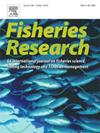在新喀里多尼亚,环境条件和渔民行为都影响着鲨鱼和齿鲨对延绳钓渔获物的捕食
IF 2.2
2区 农林科学
Q2 FISHERIES
引用次数: 0
摘要
大型海洋捕食者以渔具捕获的鱼类为食,这种行为被称为“掠食”,经常导致具有重大生态和社会经济影响的冲突。虽然通过时空上避免掠夺来调整捕捞做法可能是缓解冲突的一种权宜之计和具有成本效益的手段,但其有效性往往受到对潜在驱动因素了解不足的限制。利用10年的航海日志数据和广义相加模型,我们的研究确定了影响新喀里多尼亚延绳钓渔业中鲨鱼和齿鲸(齿鲸)捕食金枪鱼的环境和操作因素。齿齿鲨的捕食主要受环境因素(如海面温度、水深和海面高度)的驱动,而鲨鱼的捕食主要受操作因素(如设置钩的数量和浸泡时间)的驱动。研究结果表明,在捕食者自然分布与捕鱼活动重叠的地区,以及渔民增加捕食者放置渔具的机会的地区,捕食更有可能发生。有针对性的策略,如将浸泡时间减少到12 小时以下或将每套挂钩限制在1750个以下,可以将破坏的可能性降低一半,为减轻这些相互作用提供了切实可行的解决方案。对牙齿鲨捕食的时空模式的建模预测显示,牙齿鲨捕食的热点地区被很好地描绘出来,这可以为渔民制定的避免策略提供信息。然而,渔船之间捕食概率的巨大差异表明,需要进一步调查与渔民个体行为有关的其他因素,或与影响其可探测性的渔船的内在特征有关的因素,以充分了解捕食机制。本文章由计算机程序翻译,如有差异,请以英文原文为准。
Both environmental conditions and fisher behaviour influence the occurrence of shark and odontocete depredation on the longline catch in New Caledonia
Large marine predators feeding on fish caught on fishing gear, a behaviour termed “depredation”, frequently results in conflicts with significant ecological and socio-economic impacts. While adjusting fishing practices through spatio-temporal avoidance of depredation may offer an expedient and cost-effective mean of mitigating the conflict, its effectiveness is often limited by a poor understanding of the underlying drivers. Using 10 years of logbook data and generalised additive models, our study identified the environmental and operational factors influencing shark and odontocete (toothed whales) depredation on tuna catches of the New Caledonian longline fishery. Odontocete depredation was primarily driven by environmental factors such as sea surface temperature, bathymetry and sea surface height, whereas shark depredation was primarily driven by operational factors like the number of hooks set and soaking time. The findings suggest that depredation is more likely to occur in areas where predator natural distribution overlaps with fishing activities, and when fishers increase opportunities for predators to locate their gear. Targeted strategies, such as reducing soaking time to under 12 hours or limiting hooks per set to fewer than 1,750, could halve the likelihood of depredation, offering practical solutions to mitigate these interactions. Modelled predictions of the spatio-temporal patterns of depredation show well-delineated hotspots of odontocete depredation that can inform avoidance strategies developed by fishers. However, large variations in depredation probabilities among vessels suggest that additional factors related to individual fishers’ behaviours, or with intrinsic features of vessels influencing their detectability, need further investigation to fully understand depredation mechanisms.
求助全文
通过发布文献求助,成功后即可免费获取论文全文。
去求助
来源期刊

Fisheries Research
农林科学-渔业
CiteScore
4.50
自引率
16.70%
发文量
294
审稿时长
15 weeks
期刊介绍:
This journal provides an international forum for the publication of papers in the areas of fisheries science, fishing technology, fisheries management and relevant socio-economics. The scope covers fisheries in salt, brackish and freshwater systems, and all aspects of associated ecology, environmental aspects of fisheries, and economics. Both theoretical and practical papers are acceptable, including laboratory and field experimental studies relevant to fisheries. Papers on the conservation of exploitable living resources are welcome. Review and Viewpoint articles are also published. As the specified areas inevitably impinge on and interrelate with each other, the approach of the journal is multidisciplinary, and authors are encouraged to emphasise the relevance of their own work to that of other disciplines. The journal is intended for fisheries scientists, biological oceanographers, gear technologists, economists, managers, administrators, policy makers and legislators.
 求助内容:
求助内容: 应助结果提醒方式:
应助结果提醒方式:


